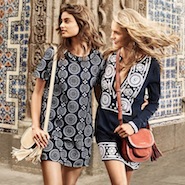As United States businesses seek growth in the face of declining sales, the solution is not overseas, but with a new client base at home.
According to a new report from Unity Marketing, “Brand Stories That Sell to HENRYs,” the mass affluent may not be as wealthy as their ultra-affluent counterparts, but the size of their population makes up for the difference in household income. HENRYs (High Earners Not Rich Yet), defined as those with household incomes between $100,000 and $249,900, account for 40 percent of total U.S. spending, making them a key audience for retailers.
"Luxury brands are facing a changing market and slow growth so finding new customers and new segments is critical," said Pam Danziger, president of Unity Marketing, Stephens, PA.
"HENRYs are largely untapped, being viewed by many brands as ‘aspirationals’ but not there yet," she said. "But HENRYs have high income, only one step down from the ultra-affluents that luxury brands traditionally target, and disposable income to spend. They are the gatekeepers for the future of luxury brands.
"HENRYs are looking for luxury, but in a distinctly new style, different from their parents’ and grandparents’, and finding satisfaction with new brands, offering new luxury that connect with the HENRYs’ mindset and values."
Up and coming
Retail results for 2015 were the lowest they have been since 2009, dropping 0.2 percent.
Retailers’ share values are plummeting, with stocks reaching historic lows as earnings falter.
Nordstrom stock stood at more than $82 a share on March 20, 2015, but on May 20, 2016, opened at $37.25, its lowest in almost six years, and its competitors have had even rougher fortunes. Retailers are trying a variety of strategies to get out of the rut, but broader economic turmoil has walloped the industry, and no clear solutions are visible (see story).

Nordstrom Anniversary Sale
One solution, Unity Marketing says, is the HENRYs, who are heavy lifters in the U.S. economy.
HENRYs make up 18 percent of the 125 million U.S. households, but they control about 40 percent of total U.S. spending.
In comparison, the ultra-affluent, with household incomes of $250,000 and more, represent only 2 percent of households and make up 10 percent of total U.S. spending.
This difference in population is great, with ultra-affluents only 3.8 million households to the 27 million HENRYs.
Another factor pointing toward HENRYs as opposed to ultra-affluents is buying behavior.
Whereas HENRYs might trade down more and like to save money, ultra-affluents have the disposable income to spend, but they are more concerned with conspicuous consumption.
Mentally, someone with $250,000 today feels more middle class than affluent, and luxury marketers have to adjust their messaging appropriately.
HENRYs specifically are typically young and highly educated, employed as engineers, managers, entrepreneurs or designers. One thing that connects them is that they are all on a path toward greater affluence.
With this younger generation, the ideas of old luxury typically do not appeal. For these consumers, a new form of luxury holds more interest, the kind offered by brands such as Detroit-based watchmaker Shinola.
Consumers on average reach their peak affluence between 35 and 54, but those who are 35-44 are worth more to retailers than those in the next decade. HENRYS who are 24-44 spend more than those in the 45-70 bracket.

Millennial shoppers
Another reason to court younger clientele is that these are the consumers poised for affluence later on.
Within the affluent population, the ratio of those aged 35-44 to those aged 45-54 will hit a high point between 2025 and 2030.
According to a previous Unity Marketing report, as baby boomers age and millennials mature into established consumers, luxury brands will have to retool many of their marketing strategies to account for the generational shift (see story).
Some brands that are particularly effective at reaching HENRYs, according to Ms. Danziger, include Warby Parker, Apple, Everlane and Tag Heuer.
New normal
Consumer behavior and values shifted drastically with the 2008 recession, creating cause for concern for those who rely on consumer spending.
An executive from MasterCard Advisors explained that much like the “Depression babies” of decades ago, today’s consumers are more conscientious about what they buy. This requires a changed strategy to acquire new clients and convince them to shop (see story).
"What’s interesting about the shopping behavior of luxury consumers today is that more of the wealthier ultra-affluents are shopping like HENRYs than the reverse," Ms. Danziger said.
"HENRYs have learned that shopping smart and wisely can mean they can live a lifestyle several rungs up the income ladder," she said. "And ultra-affluents are finding that they can hold tighter to their stash of cash if they do the same.
"Further, most people who reach ultra-affluent levels of income start out their road to affluence as HENRYs. And it is likely that brand preferences and shopping behaviors forged while they are living as HENRYs will be brought along with them into their ultra-affluent lifestyles."
{"ct":"5TA7NaZw0o0Fd+9KmBVa4IjWWj405JbkeTFTzvttirHALZPV37LRyKHJdRlL6XkUFqgxuODnFZTb81DJ7TLfMuIJtxQfdw88U6EYlIKasOyGfV9yyDsqt7Sa9hnqtFs50SdILMIFX7YDGWcv4cXvT37uwy+EkQqmHVn0G7iK6wlsvODbOA8s8hSNtAO6IKKySUxgvZUsLl+8b5QgIC1KoRd3P1FB34Cdzvpc+JsXLW4otu+vmjVnrkx9BOIvis6p+SA5HRl6bl27FHbQqGOsUNGGxgxIZPGvsjo3CvqfhkNuRM+\/6KH\/DrUkmz0Vp7BrSUj52xFhVezuIWwGvnBEy15FyNIMRTkGJPykc\/trvbd7QqtnbtJfCF8J0JxKxnCrMss1oeS1T+XmDnr1BT5Mjwg4osonv4HQm1+gEEvdI9cmmW3ILx3F9ZcSnOyZCkeUDZzOyZc6Ui6ojQDMvGY+HxW9zRTbwKVDq3Wlg1KCyPo9NUkuT7P0LGZCh4RzW15XBokl6zZoas8mWafkx2GUhiqELhwtMcqVW1i1Hp35NAlgloZSZOQkvNg\/w3t\/JwacN18kc2CE4xL25WI2RjQWM+k2uO1HS4PnuHaivZOixK09WXMC1dc6Qf\/q7tAL6JjLSmMhG6jmiDnq9VUGKDWxakn\/+OTAcSmQSO5Me5tgsV+uuH9eqOK1gGIZwPBssr5OagP5Qj2pQfMLJ3wVSu8JNykExS4tjJCCtcXiejI9Ss1ZZL0waZyFMijeFqDYr3rUbvYbYI+hHxvvLbifXbcJBazY8jisdR1cTghSAHXHZdLccPajbOm8G96mdIgJ1bD7y+IQU2TfSazWFkZKkqaWJuY4Ax8Zr1g9ZZnR8frYQ04uzK\/0QMW4\/qng\/wFBDrKQh\/IZrBsu1oqKVliBg9AD9YV91K6E9rcEK7AeCoNRoK5IqiEzMx8aalsDobClgs95Sgn9P6hxO3DxqB5Q0NFgL5zTVE1Qwc\/gysDaTusVGXVPVn57tiHwHM74AYekked4luEsw+SZvnCZjcP0MCgp3\/JUdoDZKExM2HCcGun44ch2XhiGFgimY0JCgJzt+V+cBP1gwX4ejq\/LWMSQ\/jDpfwBjrO8UVyOjsX6Sa25Q4TAsqxHkARxqSdJwkRhZWLd0v3ZNdFhn4EvJNoUpBAe8Ir1xJADuEbPXlGyhk1QW+xvB+8SiO2ABPmwKWpwUc87q7PwNJWABpVwuBnqelAWK\/IjzvaE4m3c1pdiqxyHiO7t85pENcFXw9q0m8HYGKLFJ3WHQmASjpfTBQ3wFhRXkFL6gWL0kMsTP7ariUb4cBe2YOkScmeW3c7ZzGU3GPc7Sk7bPfjDFJHlFo6AiY4LnR+TgrEF4dcIhRFMenmjH0K1HtFl48Mvc4F3tLqtY1ck4neBO24oQ5Chtrg3U\/fwHIDQLc\/NRWQCXELPYs26Uj4fWKSx+47SP6QS71V7Jz8QKQU2XXhFg2MDEHBu7O\/ngjjeKnS1PPYT+x\/SN9b\/l+P1oFBsKpnSsbCcFkCP1bxr+h2cuHmQSerDwr3ewjBtEP0KHO\/fFFhYIytNYTM7ymK988BEJ+0mWvQwaNlyUZb8BIpF7MQW0kvMCqC0kikmZ3dY2JPUylEngIJ19dkWDqtfLU9Bz0P1pm+w+xcu3D9gV3KZfGTQESYvkpknrLYOreVxJ6sjRagw1N2v5Izg44IcwFKcOocW67737U5WxBRjUkK9fwzUAXKAEZjsyXkoST+ba7WQD9OjUDGki+bN0+1p5miCrrRANXT7U6o+AZKFIlkIZNzrflzE7AanBkJlTuhdoMsUpjY+Svwepr1nI+14syxin54c2SRLs2\/ajm7ZHYUbxUfDDBXWAYVUs4nVS6KQzJhQbrrneCc0Z7QmHzOvHsjPnrIUea2zliSPkux89zC64SME8Gm8wEqKoEC4igcz7jkadcYnASrteejXdywo87wnJadgoZC\/iGkpqRVnKM3QqjenFTdrQ2ZceKUIOmcUVxPJZIxVAxV9D+V9ZdOz+yCzB5M3fSF7XqMMlCzqI5w8I8azznaycJW6p+8liFdH2TiCNKWRejBc\/AYRce\/eYy0HDNlq4HJBKp1YOi6gUUK252Fr2M3nThvytyLHKEG4KvNXbIy2pwasLzRwI9VCU5h5lO+GrVgKkXMiZaszx2SWDEmR4zj8j69wON+OFZPkQinqgFqMQxwoEjh6NSMq3\/GI3jBJck+WHSuF9bUUFeqMZCjNqfYco1hG0ZxC+MqkEY\/wqLsd2acGQ1l3cmtJooOdIvUtQYAXKKPGXtmGEq15oTTHyuRwnWujjujrq52hlqhfhEej67+TvAWp6G7VrNcLWSQnZgr3gVfKrZEfL1p856IUWZ3gGtRElXTTUsGZLxbT0b30dodgaW3snP1EX5aJxUEsrebKqDy68Cqx550nQSNUzGcSBjnFuQKja8ZuIzSNogRyIYfia99StQztVtt3\/bZ2jI0OYbboKwMH95Qi3LG7ATAiXXx1qoM\/xU42G0VE9FbKHeOvl1L9mNl5EUfElrxb2DPVJAABr6nZA9OD3ynXVSHu2d1+xbpjGnHPnlK1WVVGW0vIEpW7IY2U0HCBx1UsZteaHrp5ezvaNZWZC4Mo+q+D1cqSbvdBAQNloxOfKrn\/jJ+R2P8DA2mTwetBFn3Vdk8InX1usNY0aulajckDS+y18+eSSW5XWahbeYxmG3khifNCusa7FB2mgmnP035t+BIVMadX6DhEtdKnYDC1\/nZIPkVOGqSPtAPwqRuCp8AxGoNlAClspIOOefIrDYVGFbCe0DTOMv11\/djgh1plurjlO+NS\/zsMgH9fDGWYsj3OXN3+JaUUHf6v3I9wVK8gq9dZqqUkBNElv7scUA2lnEnfX36DSrrvJn7H4t\/4E+FbBV6eIL91OW2LKbO5d2Z\/N6EXJA4FKifCPSR1R9BgTkdEA4piumM6blFqvq+M3UWAFJbR6\/FGclz06HHfg\/Dt0Y3SMC39FRT3MkCJD2kc6tjL5ipw+5LrdCcPmKGg90QcX41ue19fCho\/T2kQLLdpW2HhOdo0OzKLUtbRFi4kT0c5qx9l5YXCMcOf7ZXV4yThyp5L9L7XVa5uF3KwpNMCMchbZDtQDCiHYHujFwvTNgjHhNqoUhOFlW\/x5u4Gqp9EYLsFNxhXbkl84gRsZuRSiRPp+8a8mbflP5vp0d+a1UuGyXgneIUTukmxdIKYMZ96\/pfNEfGXa4OOoVomYzL4rjHHyFEWLoaTPdyvrAXZ6H5NYPO+sLAoagYOuYKE63QR7UrARnbO9ZcVPoKkFdp8iPZzr\/LxJyEOVub5jspfMyboFg8c8gFfrFpG\/hPtoqYk3oBFHtRiUVZ2LA0VNP8klLo45S4mS8XUXIf7OPqHGWKgwBo3EANLGcmlROlcmDhlydplsr7WBIM6GWgfN+HDtWTGI1T6q2SBLeGg6TLA0UnuoTICIqmmkI7\/zBVprQpLzw9rLkQ3R1cpL9eEeGMwlXOwqQstpLLJjzhtBqIWPetpdRPymfxBB6wKCR4QWkVypTGSdFoNdNnf+OJxJgmt9R08ynA4noPvLI8wVpE9+Hm0stNaE\/jpNgaldZuDA8oIEyGBbrj1itpXL18J4k5zyOp9QNymYFkNIS79hdgwpFI0mgetaHx93DYSeRBb73IueY+54hofE7NYOZiUsUrOGSzYvDCT8XEhptbls8LuFyIPQn\/RoY5HQcyr5z+ljhjQGhxWBh75fNhqctjNOij\/Pv\/dwIx0L2Gpt\/qoGVEoxAJ5VV1YUY5l1YYO58ivyuEoJ+f6HgKgthsxwJy8c6ftdPYiii3qnjOlT6IAQhp4xobeYIK014CDKXw6FVVvBWPKznY6N1SIAMPsg10AY34AqO9iI+VOL3\/IMlYuewTUJJNb7PcOC9eM7\/kpklD7tXcc81yxb\/1yV\/t3bSgM1faATdbC8X3FwWT2dBq76jDd5xbBV7bcjdALi\/RclHM7HjrAxcvPSiZvyB2k0iavwa0piAS5pjRtOBKHm7u52NSqt1BRzLwk2AV0fG22SQ5JatCNl9RlgSrETaiKbS+UIaQ4bQJq8zD4wKDTxW8Lgmgh4pc5hGpntLC9Z3WybBJbXBihlL72+nGj57D3BL59pGSXggTHUUle76LradVbLJTECcQBPPgq6l8XAFDhn2r4EgnhR9Wm+pyiGMF7YdpwZyKZr0sz4QUQiYj4yWVexlaw+u3l99Izty45DUdPdns50JyyKp3SsSI0qYi5NX0XdGwdvVrnNCVAR+Hoet1pyErqddHNHQbbQWUcKgAbmpcYrLzgEzhaKb9gd\/CIK5uvD15cuSJyaRiUsQ9GklrgzQ6s5oB0AA6TSKxyuMNsOC7pI+pa7a8YIPnPv63SwAQY\/UmAPZwmyjJGoYqiyYUOmmmKTEmwFL0WL8GUnMGqZwHZsZX5iOBsRl+T6ksmC79cfAVxVi+c7\/\/FqV9I9QsLJlkXsEX176D6BBtT38MpVmNkaQ7VZGYaLNJlWu9FBYjD909dMJ86vL84dUTNoFevZxkDJKA0cKGX6G\/XCxDgzzHszHrX3ASkSGl8pvx7ySawz6G7pnrzxQ2aahLsWzK6d43mvJ0VWv\/XxQp1qGjdJsc+R0KM1po25UbzsyX9s12Qjmz8ds7\/+klu5Dc1DUcg3+wAkK5M+6zenIJLg9RfbY6nTtSDxsi1eHYncpesiDFyfgoTH\/UeUsdAqwNAZ9i6y3lbnL6S6kb2OEHTnT733W4ylMStg0CFrdJiFpp2OKLbvG5QzZfYmNVWEj2oqWAXMWYRYHM2QIETcJB5e7tm\/JraE+++8oUBAOEmMObcGfrh1V37EMK24TDPRzJ\/EIbzMafZ7E0AmoleuXZL28zDhUCto2d5AE1sNS1zoaNx5Sh9oxWb34Blvw2Yd2P5WAGOXOaeNRLjkfFZlpfuCAnKD0KMqIav2qARUkkGX3jcQLJxtpnnt4efzpLgUhXbOfP2Bi0XAPycxxW0KcrfBztzRNKVJeDNDTfMgI94dN\/1dmyHv2ktRzIYqwJeamxnXfNSKjyIiCdQQxfi30UBWL2kxcHswyviT+sc6kQCGliY7H2V88mCptEux\/X81XG2LDENsKjDsH11UTM9m8aS3b7mZfas2penZpbwr13Dld+7QoBjDeCa\/2qAmvm\/vafDeKAkj9gD\/dfZJZA80jvNlZLBRFHBtyB79yf3Sg2DcqkVXyC51hWDjzcbjlTmfLLz5EY4HzKJ2xX75gmV5pTUuLpZv80wCWj8XAB6sj9BCiIDs5zppeMNoae7m5rxzzvMfqEw3aqhptXBDYu3ro7+lu6yqo7Jc\/yy9UmCn6aM19+H5j\/8yx33kW6DEvVJBoS\/IYc9pKaocCX5m0b9nf+dEeS6720ivEXihVD5avL9suYEg\/a0N\/don5OqbX3bIfW3+6EGthSJSIDM2Axzmf8n7zaRpfP8LwlzZsE0B\/twYxqIxzdyPbaY7AhcWkV\/8rTRl6Q2SOVA18AXPwOfyEa\/6uAzqUI6M61x+X4xFeWBsp\/MJCdt7vWSqeJa20x6oNr+kW9LSWZ\/8h\/HACAjyLYDluSmcksJh0pLcl2qyTgW\/4qg2Kn2Bqt4\/PCN\/H8IgXahmtWgHPREelMirb3TSbfpK6nrxT+QVwSvi64tGm6w0Lq+ihcMtngtjjrtQpx9dRZOoLapUksa2Zobil8Prd5dDvdTnAvmEM4QVvkJtOr2rufGoAk\/Uy9jptBhxLyLizPtZy0W6HF2RXKfRyrSO1jmTdCdgvXkbhJ946eKZJ6JiXXYmS0\/sxZa6oTQ72iaTn\/6P2zPwjtqO4S42u\/vzpeOlCzh7X69h0RE1ykhR0OwlTOx7VaGF3CI9FXCD9OJRj0U50iXCaV9UE3urRFzPCvlnEiJ3eP2o7M0Hso60r+UsHnA1ShA95oJ7fs+lJ6RC5FgW2BYGzP008tNDih2d5c7DVXcuvFeJBI1xhe+nIvGSPos7T5zAQNuiSFjIvPCbkmIQwlruOEXyu5SbEvyJPS2N2vPH9vUV2kmu\/A0LZxyq+psrUStHgrQhgzs1ylVGKDHPm0t0qkWS8SMJlRRGCfLq2Mkc8B7jS5WiZYL9lkNSnxxbqewPpA5wetNM0PDNPsPmcUQnQw1XAkamh8kOu8i5OLacUuqHT6Kc4nvVPH8NDckxzk7y986sqMBtO6UCz3cVnJloWeW6qBFvD6gRxkJfFRaHHqSe2BSOa8ijD2RFwUKsYn1MJDMKNaqKcbaHg9drHPP1MeSa99\/2Wn3TMWqhu9XHMSa\/364UHREcrInN60jcIJnpGq4uLgby\/dHDmXGpVPtnoyiOzqpkYuzMrMXezAdnAmEOIeJsYPoQ3LFykEbDWd7AcwejpZHn8fmGoCDUfjvlc2vzhWAzRC38CEUVDVUYFVa+NDpY41x\/IaJZCWWt2WYXNCzEmUEusPAoeZXWTmvsHjwVyfNcLl7rG6vXgFuA9RncebBIVaUAtOjkgXCJEYq9TBkRmz80A3YH41qLXm0\/FfD+9HciwKZEcoABwsic\/cdbEU80iItInYZlqqW1PSWxlq+qAFfZzD\/eP5v8JHutofbHsvWW6rCo5JA4RPb5jt5XfHoKwQs2klxqu28tCedywR6SEe\/CAGH2qKRV09sVPYjx8lt8uyGfs9avgxHazMAh2G6xN1HPxhJ77K6EzAKF75lkALIvQov1sDuTGbBBiGxL1ntqGCr5eg+BkjZLjWYcWgUkl7QIibJLkDuS7QcIUo4bSkqFEM+AoJaWuTbT0tpS0VtEntAf6qrN6I+ZjYNtbybouzNOTbZlQCBSvyXHB8gekRCErJ2Z+U3FfvvoIk\/+BrVY8VH9LDeB68rvQ8ymx9CyTzSMTYT5VUw82vaMZAFlDyYsoTZ74dApvwzA4fiJTGH3iZ3GL1Yump4xC7VddpikYW8194nwXWDzDJ4VN6lfdHxK4wVJUSqFlW97edDNDe8ieYgYJoq9VnkgrD5pSlBQoiqdWPJHVTZibMRwL49KNEE+dv\/3sdftmVe3jovjZES1CoHil94IkXWH1rhWmDf3p5fgvVlEwC1KG5VbeiiJlrw2y3nNBa0PAcwM4xQiLowrVd9r7DzQ9Nxa4\/joUKewUEIE7mtZXE+9YdMtkSWP3MKdWAXqrbjgm+f\/mnPB0m0vyB4B83DXZpyozE7h9ccwXZ2nRn0jGWxfSRdvzgyUFhnlkwbTxhL89zTetKwYBv8hEDHEnygpAjaSADxZUJj+sFiOa2dh2gL7kdZtvonYd7wQEHCrmfsK2AsbxmXV+84kSCCt2VmUz8EMtcSsuH766\/+s2dd5HB3B4NOF9Jw0NK5B87rtelmB5aenzNebZj+kBofjKyRhGOHTgyxkxMAfZ6DFsfQo+MJy\/3hhLLTlGoMsvW6lIRSh4NaJa+UgNZN2uma4poR1iHQwV+ZgEzm\/WlwVVLmjLR2FbsiVZLTAMajhoVc2XpKtBI1LxAgbuQTrhCz3nTETWn0msjpW8hl+1i4eoykbtLqXmHH5mTxaKx4T6oYMcKF9wu1+Wo9zV\/2u19R2RrDSQTJ\/Vo+MnjYangA0KUAwiyPjtjAMBuZ5uAr2cnIgSjw2hAXUQA5ccR6xmYNuhHORCrjz4N2WTqTQjOnbYHcKvGVOY9WlD2\/4qhHOIayKC4geQBkIde5jVQFa05tV4XJ+grrJ9n9jV\/9S6Kwh9OwgQCWLz33O8eBhxNPBrhxDASieKyelJz2sdeY1SqpNccsXAx1pCPAV1AG\/u\/uc9j7zH7AKl3KVMjShQ6+09sHnSp\/vzMKyGG\/ew0RcMDwy+v0s3n2yxFNZDBX\/3ZIk07WYZoTLaIEmLj+R13yu3\/bCeZG8OrbunZOmEt3Cua0YM1dF\/l3Q3b7c6JiryKTQtzQ+xLC1xGNuKN4OWNcE19sC4wH96j3nECLyFSoVhctFkITc8vFIxfw9YD8PCffM4R7j0A9xFWj2oo0Gb9gFKUWd\/GN3l7GOKIJNjI9AyadjXasIX4Yu4f6gVJmJUp245SJt8qqENwBLawwdAMfqOs1TRLOmOK9TdWNck8M8cCeYPikAk7TMiTtIsXarpCCGt4bxy8xZzIqaxVBUdwXu7zItgIeeqbRQUVKuXEVDtL70wvZpB9LA0+XpqvME3BraoBbyaTRPQbAVbHPIoLZdIan2CTapM5GUvP\/IojAM91isr8qr+Xepf3HKhugbvKacHZEIyeK0DNn5SLrXIgkETTjoZxjh3ln4NAjvwbHmB8lOxq7kHZlVJqpPk1LYcgEULdmilMjbIm98HAyYI5ltVrnEJZA1Jqh6Xw6U8lz1Y6t2or\/gcXV\/yi6FV3BL36exWSc8gCp2x3ezPMCyCtqhV+Mr1YPK2B1fryJV04lsaTq\/xvX2MQbj019VfCBdnf96NjLMXM9G1IlxSPTT1IiK+ZWW\/tU75noEq\/wsMkGkuKtMGcUEL3cN1Q3GG7lxjvcNomu5AFtU7mlBA3Fz0PPL\/70mxQgadY94ssAZFTZn6Z8kHcJzqRjTN9+MfRkTeppn4ZUlN34A8BnRbZ6gCEu7azRALecuxubHFOz7bTvqjJdOI839Npd\/g2\/ED1kT4Lz4G9ue2T+Jv\/z5M8HMav+cOGJEv\/kRwM5LXovlK9lXGshFqVAPf1ycFx2376COuMIPSy7vZaDK6Vd8LvXRVac1KgH2wehVSzj6DnoIF+J8r0G3ebVoXKY9RTeCvQZVHJCVPaa59kgWgucEoCooXfHz489YfAqptam4E+C0GjFwXQhXMPPT\/DjohqEFzuMieGe4W5uGJhb7hTeet4EjKrJU\/TrmkGqtu9uXnIw1UVX0Q96AtiSJ57Lwy9dyZna+I9fxPYnPodJ5x5q0LvT4eE\/ben1VgkFdy2zWCd2x0ltuBNa4icYCMTT1SMtq1hhXW37tOJTPZ3e48KdULulZcZCHAZIAuPyx85p6iOJ6oogZFZni3fdz\/NCn3JvnUbEhQN3aahO+sCHE+Sd5f+sTqMrtsHsneHh9ApsNWHX\/SNUZUSE\/mAYFNB3h2lsma00WVaiJWUHUVpDPpxsHKMHqFpebeGhLNqdohPKVbFVQsMo4BsTn0z+x5EauAKgNsM3iohxzdU4+4K2uMWrJvswMZpluUJ4tkZkbSC+fMnseHLqYwPaJNpJNN2IoRMZN0hznwGPIUcpWOvw=","iv":"7c4682bcf059a7d8ec21d8e1837d4bc3","s":"4c88da2f429656c1"}

 Michael Kors spring/summer 2016
Michael Kors spring/summer 2016